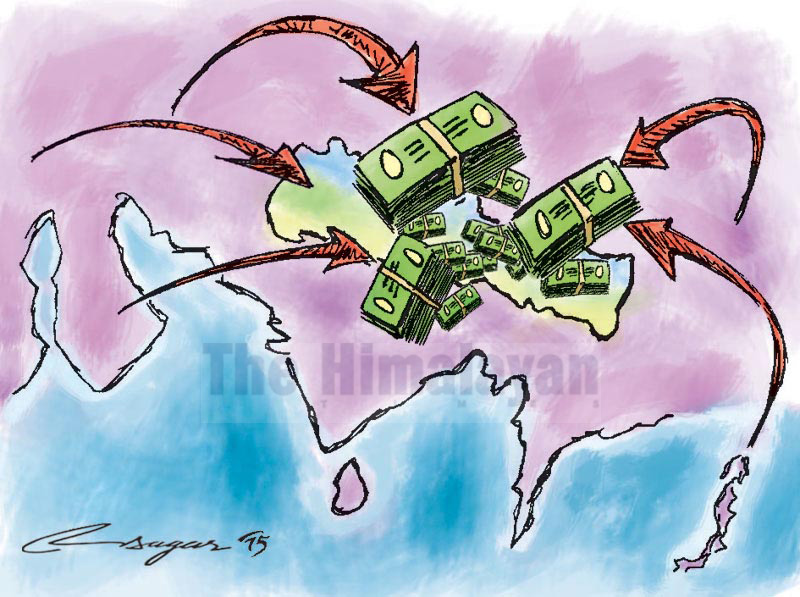Remittance surges 23pc in first month of FY 20-21
KATHMANDU, SEPTEMBER 25
Against the general expectation that remittances would take a major hit due to the coronavirus pandemic, the money sent home by Nepali migrants in the first month (mid-July to mid-August) of fiscal year 2020- 21 surged by 23 per cent.
The Macroeconomic Update of the first month of the current fiscal year unveiled by Nepal Rastra Bank (NRB) today reveals that remittance inflow surged to a whopping Rs 92.71 billion in the review month compared to an increase of two per cent in the same period of the previous year.
According to Gunakar Bhatta, spokesperson for NRB, remittance inflow may have gone up significantly as everybody was forced to send funds home through the formal channels only.
Stating the rise in remittance inflow is in line with the global trend, he added, “The returnees have also brought back cash in recent months, while they used to splurge on gifts and other personal items earlier.”
Senior Economist Chandra Mani Adhikari, meanwhile, opined that the impact of the coronavirus pandemic on remittance is not quite visible yet.
“Thousands of Nepali migrants employed abroad, especially in the Gulf nations, are expected to return, which will take a bite out of the remittance in the coming months for sure,” he said, adding that the strengthening of the US dollar in the review period also made it appear as if the remittance flow had gone up significantly.
In the first month of 2020-21, merchandise exports increased 8.9 per cent to Rs 9.62 billion compared to an increase of 27.7 per cent a year ago. Meanwhile, merchandise imports decreased 19.6 per cent to Rs 85.81 billion against a decrease of 11.5 per cent a year ago.
While the country’s imports continue to exceed exports, the total trade deficit narrowed down 22.2 per cent to Rs 76.19 billion in the first month of fiscal 2020-21. Such deficit had contracted 13.9 per cent in the corresponding period of the previous year. The export-import ratio increased to 11.2 per cent in the review period from 8.3 per cent in the corresponding period of the previous year.
Consequently, the balance of payments (BoP) registered a surplus of Rs 51.46 billion in the review period. Such surplus was Rs 6.05 billion in the same period of the previous year, as per the NRB report.
Meanwhile, the current account remained at a surplus of Rs 25.41 billion in the review month against a deficit of Rs 9.34 billion in the same period of the previous year.
The country’s gross foreign exchange reserves in US dollar terms increased to $12.02 billion in mid-August 2020 from $11.65 billion in mid-July 2020.
With this, the foreign exchange adequacy has increased significantly.
Based on the imports of the first month of 2020-21, the foreign exchange reserves of the banking sector is sufficient to cover the prospective merchandise imports of 17.3 months, and merchandise and services imports of 15.6 months. The ratio of reserves-to-GDP, reserves-to-imports and reserves-to-M2 stood at 38.1 per cent, 129.7 per cent and 33.8 per cent, respectively, in mid-August 2020. Such ratios were 37.2 per cent, 105.7 per cent and 33.1 per cent, respectively, in mid-July 2020.
As an adverse impact of the pandemic, the government’s spending and revenue collection have been affected.
In the review period, total expenditure of the federal government based on banking transactions (excluding direct payments and unrealised cheques) stood at Rs 1.95 billion. Such expenditure was Rs 2.62 billion in the corresponding period of the previous year.
Similarly, revenue collection based on banking transactions (including the amount to be transferred to provincial and local governments) stood at Rs 58.81 billion. Total government revenue was Rs 77.53 billion in the corresponding period of the previous year.
The deposit mobilisation and credit disbursement of banks and financial institutions (BFIs) also dropped, shows the NRB report. While deposits at BFIs decreased 0.1 per cent in the review period compared to a contraction of 0.4 per cent in the corresponding period of the previous year, private sector credit from BFIs decreased 0.5 per cent in the review period compared to a growth of 0.5 per cent in the corresponding period of the previous year.






